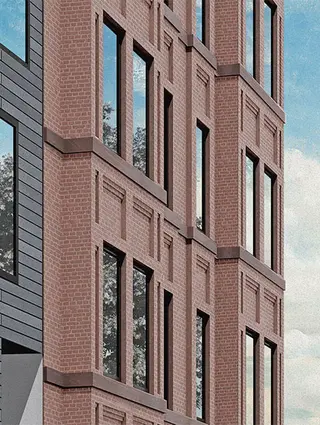 Carter Horsley
Carter HorsleySep 17, 2015
Carter's Review
This pleasant and rather conventional, 4-story building at 4 Downing Street in the Clinton Hill section of Brooklyn is a new condominium residence project converted from one of the city’s most phantasmogorical residential whimsies.
The conversion was completed in Queen Anne-style in 2015 by Barrett Design & Construction and contains 8 apartments. The original building dates to 1895 and had been embellished for several years with architectural flourishes and accoutrements by Arthur Wood in a project he called “Broken Angel.”
The project also involves a narrower and more modern new construction building at 8 Downing Street that will contain two apartments.
Bottom Line
The new residents of this low-rise development may not realize that they are treading in the very wild architectural terrain of the site’s former owner who cobbled together on this site a “Gothic” tower of “Psycho” heritage with Gaudian overtones and the jig-saw compilations of Friedensreich Hundertwasser, the Austrian artist who died in 2000 and was best known for his extremely imaginative, colorful, decorative and sensual buildings.
Description
The red-brick and brownstone building has a six-step-up stoop and a symmetrical façade with vertical indentations and inset spandrels.
An April 10, 2015 article by Cate at brownstoner.com noted that there is a mural on the project’s construction fence by Tom Fruin, “best known for his stained glass water tower sculptures, and a “forthcoming roof installation on the building” reflect the developer’s “desire to pay tribute to the artistic history of the building without being directly referential.” The mural will be installed permanently, the article continued, at a nearby charter school.
Mr. Fruin, the article continued, is “designing guard rails with found metal objects” that “will be installed at the top of the building and visible from the street” to “effectively serve as a cornice, as the decorative terminus of the façade” as the “building lost its original cornice years ago, perhaps when Wood added his found-object roof structures.”
Two beatific faces that Wood had created are now installed on a stair landing, the article said.
Amenities
Some units have exposed brick fireplaces.
Apartments
Residence 2 is a two-bedroom unit with 1,579 square feet with a 24-foot-square living/dining room with an open kitchen and 596 square feet of external space.
Residence 5 is a two-bedroom unit with 1,615 square feet with a 25-foot-long living/dining room with an open kitchen and 52 square feet of external space.
Residence 4A is a two-bedroom duplex unit with a 25-foot-long living/dining room and an open kitchen and two bedrooms on the entry level and a 28-by-19-foot terrace on the upper level.
Residence 1B is a three-bedroom duplex with a 25-foot-long living/dining room with an open kitchen and two bedrooms on the entry level and a 19-foot-long recreation room, an 11-foot-long bedroom, and a 20-foot-wide patio and a 21-foot-long rear yard.
History
An article by Ronda Kaysten in the May 8, 2015 edition of The New York Times quoted Margot Niederland that “it was like no other building, and I don’t think there ever will be anything like that again.” Ms. Niederland made a documentary movies about the building that was screened at the Sundance Film Festival in 1991. “It was like the Watts Towers, except L.A. saved that, but New York didn’t save Broken Angel,” she continued.
“In 1979, Mr. Wood and his wife, Cynthia, bought the abandoned four-story building from the city for $2,100. They spent the next three decades transforming it into a topsy-turvy work of art. But after a series of unfortunate events, beginning with a mysterious fire in 2006,” the article continued, “Mr. Wood lost the building to foreclosure and was permanently evicted by the city in 2013.”
The article described the building near its end with “a series of ladders and planks traversed the building, which had a dirt ground floor” and “stained glass windows were fashioned out of salvaged saltshakers, glass bottles and ashtrays,” adding that Mr. Wood “planned to eventually suspend a whale made out of a Sea King helicopter from the roof; it would have been supported by a crane.”
After the 2006 fire, Mr. Wood entered a partnership with Shahn Andersen to converted the building to condos included a studio and home for himself and his wife. They removed the many rooftop additions but a bank foreclosed and Mr. Wood sued the bank, his partner and the city “to no avail,” according to the article.

- Condo built in 1875
- Converted in 2015
- Located in Clinton Hill
- 10 total apartments 10 total apartments
- 10 recent sales ($1.1M to $2.3M)
- Pets Allowed
 6sqft delivers the latest on real estate, architecture, and design, straight from New York City.
6sqft delivers the latest on real estate, architecture, and design, straight from New York City.
